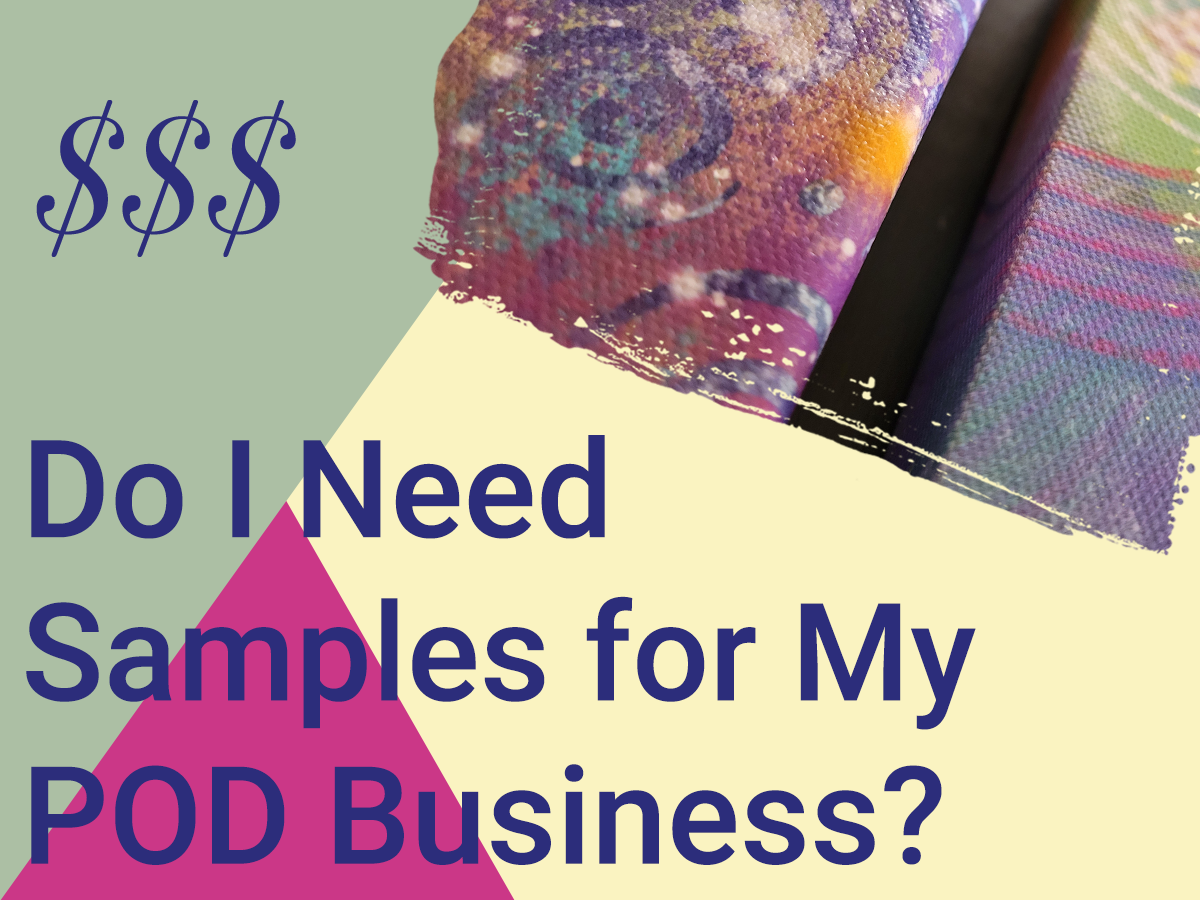Introduction
When first getting started with a print-on-demand (POD) shop, every penny counts. Purchasing samples probably seems like something you can ignore to save your start-up funds.
While tempting, you’ll be better off setting aside at least a little money to get a couple product samples. The benefits – such as verifying sizing and figuring out how long fulfillment and shipping take – are well worth the cost.
This recommendation applies whether you’re just starting out or are adding new products to your shop.
Most POD suppliers such as Printful and Printify offer discounts – and sometimes free shipping – if you’re ordering one of your own products. So depending on your product category, you could easily get multiple samples for well under $100 as a solid start.
Let’s take a look at some top reasons why this is a good practice for anyone in the POD space. At their core, these reasons are mostly about knowing what you’re trying to sell and what your customers can expect when they buy from you.
Check the Product and Supplier Quality
Why Quality Can Vary
It’s important to understand the quality of what you’re offering. This factor is especially important with a product category such as t-shirts or hats where the number of options can be overwhelming.
Using the t-shirt example, you’re dealing with multiple variables before your customer ever receives their order:
- T-shirt manufacturer. Example: Delta, Bell+Canva, Champion.
Each manufacturer has slightly different standards for construction, color lots, fabric weight, etc. - POD Supplier. Printful does their work in-house, but others such as Printify and Gooten deal with a network of print houses for fulfillment. Print quality can vary a LOT.
- Your design. It will almost definitely look different depending on the combination of shirt model and POD supplier you use.
A different combination of factors can give you different results.
For example, if you know you want to sell 15-ounce ceramic mugs, compare the print results using the same design from multiple suppliers. I’ve used the exact same design file on a mug ordered from two different suppliers. Each company sized and placed the design differently with varied color reproduction.
Evaluating a Sample Product
You can’t really evaluate the quality of a product and confidently describe it to your potential customers without seeing and touching it.
- Throw that shirt or blanket in the wash.
Did it shrink or bleed? How did the print job survive? What does the fabric feel like? - Have a friend or family member wear the leggings over the course of a couple weeks.
How comfortable are they? Do the seams show any signs of failing? - Put those mugs in the dishwasher and check for chips, stains, or fading.
- Use the duffel bag for the gym.
How did the zipper hold up? Is the shoulder strap comfortable? Any scuff marks showing?
Doing this kind of evaluation yourself will give you the confidence that you’re accurately describing your products.
By the way, check out my research project on unisex POD t-shirt options for some ideas of what I look at.
Verify Measurements and Sizing
Knowing the actual measurements of your products is critical, especially if you’re selling clothing.
If you take them, returns can kill your profit margins. And poor fit will be a major reason people want to return or exchange their purchase. Plus they can be a PIA to deal with when you’re using a POD model. What do you do with the returned items?
I recommend getting at least one sample of each product type you plan to sell, including one each if you’re using different brands such as Bell+Canva and Next Level. Wash and dry using the label instructions.
Alternatively – if you think your customers won’t follow the label instructions – use whatever method you expect them to. For example, with clothing, a lot of people just want to throw stuff in the washer and dryer and not even think about hand washing or line drying.
If applicable, measure each item before and after washing to figure out if it tends to shrink or become misshapen. Use these measurements to more accurately describe the sizing of your products.
Color Reproduction
Color reproduction can vary a LOT from product to product and from supplier to supplier. This is especially true with any type of fabric, although I’ve seen minor differences even with white ceramic mugs.
I have found that color reproduction on the cut-and-sew knit products such as leggings tends to be the closest to what I see on my computer screen as compared to other products. But even there it’s not a 100% match.
Since it’s almost impossible to predict what a given color design will look like once printed, I recommend getting samples of multiple designs using a variety of colors. It can be worth it in the long run since you’ll be able to create new designs with greater confidence as to how they will look.
Some key product categories where this is true include
- All-over-print clothing (leggings, shirts, joggers, etc.)
- Blankets. I’ve tested multiple types with very different results among them.
- All-over-print bags, backpacks, and totes
- Cloth napkins
- Pillows
- Stickers
- Mouse Pads
- Prints and posters
I’ve been surprised by how much variation there is in this area of production. How much it matters to you will probably depend on your product line and customer base. Someone building a coordinated clothing line will probably have lower tolerance for color variation than another person designing unrelated tote bags.
Delivery Times and Packaging Quality
Fulfillment and Delivery
Reasonably accurate estimates of fulfillment and delivery times are critical in online business. You need to give your customers an expected arrival window, and selling platforms such as Etsy place a lot of weight on when you ship relative to when you say you will.
As with many industries since 2020, fulfillment and delivery times have varied a lot. POD suppliers have had many of the same problems with staffing and supplies that other businesses have experienced, and 2020 was a really tough year.
That being said, I’ve seen huge improvements since about mid-2021 with all of the suppliers I use, and things seem pretty much back to 2019 time frames, at least within the USA.
But I continue to monitor how long it takes vendors to get my orders out the door. And ordering samples is a great way to do this for yourself before you get any orders. Keep records of what you order and when, including when you actually receive each item.
Also pay attention to where shipments are coming from if that matters to you. Many POD items ship from within the USA, but I’ve had orders come from countries such as China or Latvia.
If you expect to have a significant number of customers in a country other than where you live, you might have to get creative and find someone you can ship to in that destination country to test timing.
Packaging
Each POD supplier usually lists the general packaging type for each product. Soft goods such as clothing and blankets tend to come in soft plastic mailers.
Canvas prints are usually in some type of flat box with varying degrees of padding. Posters come in tube mailers.
The biggest concern when it comes to packing will be with anything breakable such as mugs or glassware. So pay attention to how orders for both single and multiple items are packaged (this will involve placing multiple orders).
I discovered with one vendor that while one or two mugs arrived carefully packaged without any problems, as soon as the order went over about 6 mugs the quality of the protective wrapping dropped significantly resulting in more breakage.
So pay attention to how your samples are packaged for mailing and anticipate any problems that might result from the supplier’s choice in this area.
Use for Product Photos and Videos
Once you have those samples in-hand, use them for marketing! Pictures – and video – of the real items are great enhancements to your listings and other marketing efforts.
The generated mock-ups are surprisingly good these days, but you can’t beat the real thing. I know with my own listings where I happen to have a sample and have added photos or video tend to do better than those with just the mock-ups.
As an example, I found an Etsy seller who was definitely using a POD model but in a very sophisticated way to create a unified clothing collection. She has a small collection but it’s very well designed around a particular aesthetic. She clearly gets a sample of every single design she adds to her shop and uses it for carefully styled shoots with real models. From what I can see, she gets an impressive number of sales relative to the number of listings, and I’m sure her listing photos using those samples is a big part of her success.
Conclusion
Whether you’re just starting up or adding new products to your offerings, samples are an important tool in giving your customers the best possible experience. You gain knowledge of your products that is invaluable in sales and marketing and can anticipate potential issues.
One last piece of advice: continue to monitor all of these factors. Quality control practices can change. Suppliers try out new packaging to same money or reduce waste – but wind up with more breakage. Shipping problems crop up at various points in the delivery chain. Don’t be afraid to make changes to your business’s supply chain if necessary.


